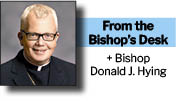
Every ancient culture fashioned idols for themselves — images of the divine as the ancient peoples perceived the holy to be. Carved from stone, wood, or precious metals, these “gods” received worship, obeisance, and sacrifice, as the community spiritually sought blessing, protection, and connection to the supernatural. While idolatry is erroneous and false, this universal phenomenon of carving sacred images manifests the common impulse within human nature to see the divine, to indeed perceive the face of God.
The desire to see God
The Lord revealed Himself to the Jewish people as the One and True God, transcendent, invisible, and omnipotent. The Ten Commandments forbade the making of idols because God was beyond the forces of nature and human imagination. The Israelites consistently fell into idolatry because they dwelt side by side with pagan peoples who practiced such. Again and again, the prophets called the Chosen People to fidelity to the Covenant, to abandon their false gods, and to embrace the living God. The absolute holiness and mystery of God forbade the Jews to ever see Him. Many verses in the Old Testament declare that no mortal could look upon God and live.
Nevertheless, the desire to see the face of God finds expression in the pages of the Old Testament. Isaiah says to the Lord, “Oh that you would rend the heavens and come down, with the mountains quaking
before you. As when brushwood is set ablaze, or fire makes the water boil.” (Isaiah 63:19-64:1) After his intense suffering, Job declares, “I know that my Redeemer lives, and that He will at last stand forth upon the dust…and from my flesh shall I see God; my inmost being is consumed with longing.” (Job 19: 25-27)
Stepping into His own creation
God fulfills these Old Testament longings beyond all expectation in the advent of Jesus Christ. While the Jewish people longed for a Messiah who would set them free from sin and oppression, no one dared to think that God Himself would visit His children in human form. Here, we see the extraordinary uniqueness of Christianity — our conviction, that in the person of Jesus Christ, God has fully embraced our humanity in every way except sin, and has rescued us from the clutches of evil and death. The Lord stepped into His own creation 2000 years ago, and history is forever changed.
United to Him
The Second Vatican Council calls Jesus the sacrament of the Father. In his letter to the Colossians, Paul tells us that Jesus is the visible form of the invisible God. In learning the identity, mission, words, and actions of Jesus, we come to know the nature and heart of God Himself. We see that He loves us in an absolute, unconditional and eternal way, that we are His beloved children, and that He desires an eternal relationship with us, beginning with the spiritual life the Lord cultivates in us in the here and now.
In turn, if Jesus is the sacrament of the Father, the Church is the sacrament of Christ. As both His Body and Bride, the Church is the extension of the life, presence, and power of the Lord through time and space until the end of the world. Through the proclamation of the Gospel, the celebration of the sacraments, the whole Catholic spiritual tradition, and the loving service of neighbor, Christ unites us to Himself through the Church.
The wonder and beauty
At times when I am celebrating Mass, I ponder the fact that prophets like Isaiah would have given anything to be present at the Eucharist and to see the visible incarnation of God in the consecrated Host. The people who lived before Jesus longed to see the divine. Those who encountered Jesus in his earthly life saw God in His sacred humanity. We who live in the age of the Holy Spirit see and taste God in the Eucharist, we hear His voice in the absolution of sin in the confessional, and we feel His healing touch in the Sacrament of Anointing. His very words speak to us in the proclamation of the Gospel.
We see Him
Because the Word became flesh, we are not bound by the Old Testament prohibition against making images of God. We can paint, sculpt, construct, and write about God in visible and artistic fashion, because He has truly become one of us. In this truth lies the dynamic of the entire Catholic sacramental imagination. God has sanctified our humanity and all created reality by assuming it to Himself, and therefore we see His fingerprints all over everything that is authentically beautiful, true, and good. Look to see the face of the Lord with renewed desire and love in these blessed days of Advent!

